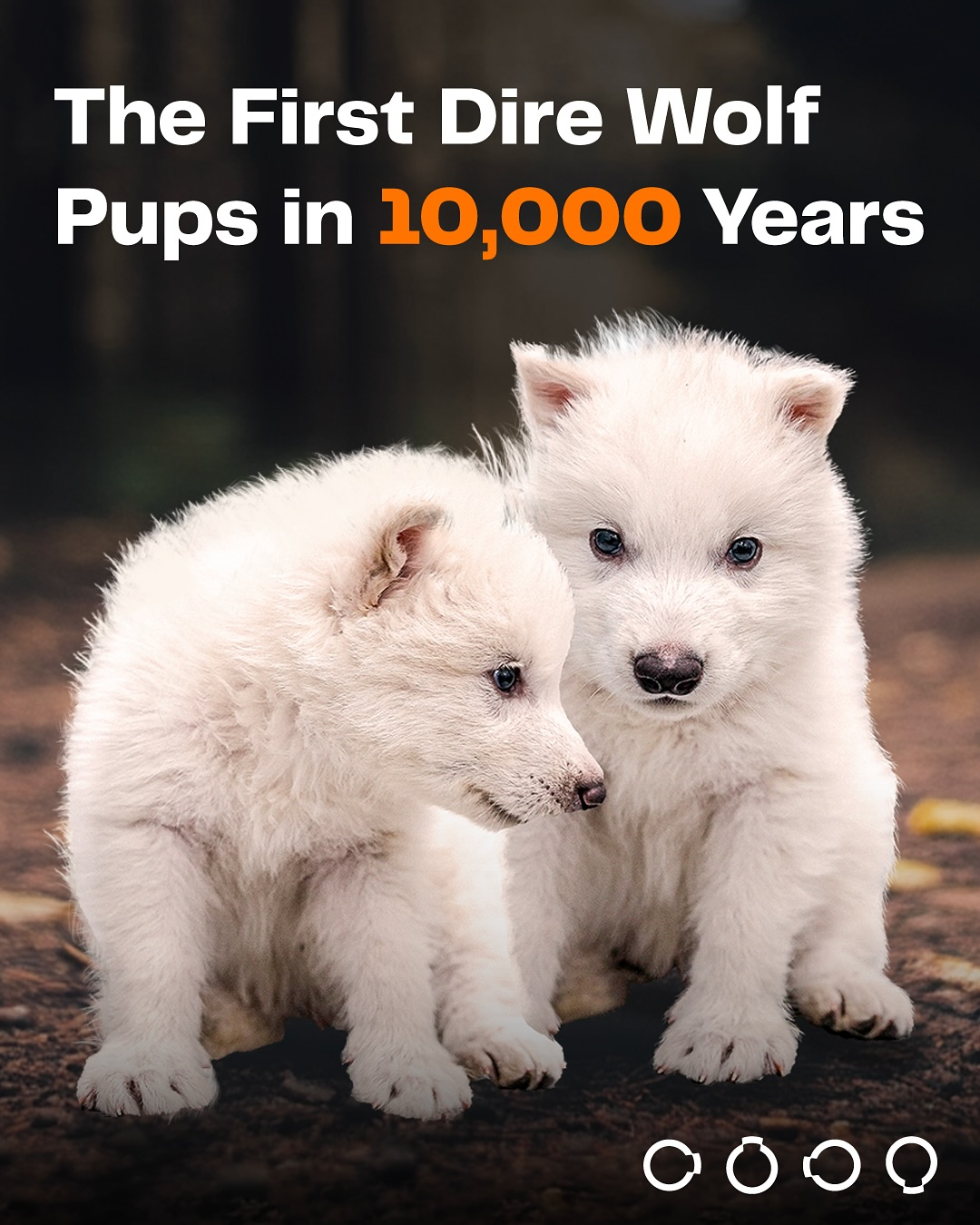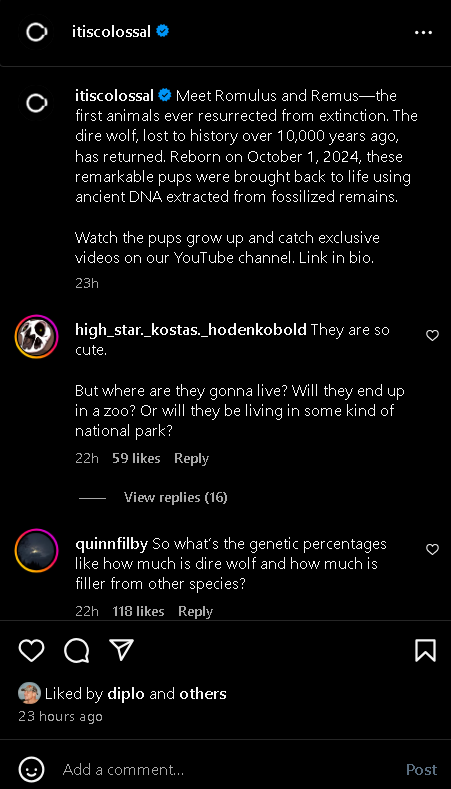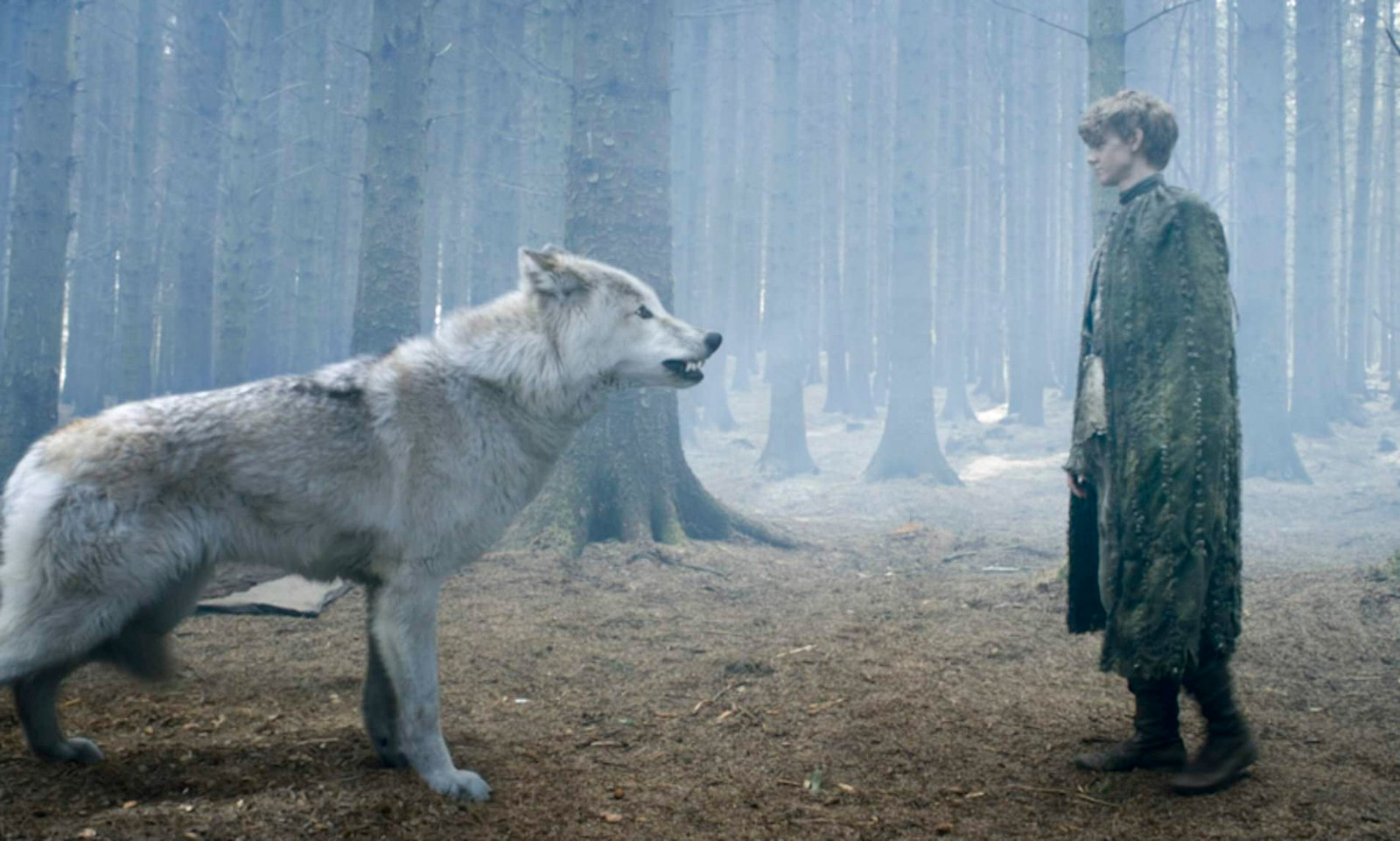Dire Wolves Back From Extinction? Colossal Biosciences Aims to Resurrect Game of Thrones Icon
Quote from Oladosun Joshua Segun on April 8, 2025, 1:21 PM
The dire wolf, a creature that prowled North America ages ago, captured our attention again in Game of Thrones. These prehistoric predators vanished around 10,000 years ago. But get this: they might be coming back!
Colossal Biosciences, known for trying to bring back extinct animals, now wants to resurrect the dire wolf. What does this mean? How will they do it? What happens if they succeed?
Indeed, that's a key part of the groundbreaking work by Colossal Biosciences. They used DNA from ancient dire wolf fossils and carefully edited 20 times in 14 genes of the gray wolf to successfully de-extinct the species. The names Romulus and Remus nod to Roman mythology, while Khaleesi is a clever tribute to Game of Thrones. This scientific feat showcases both innovation and a bit of pop-culture flair! who were believed to have been raised by a wolf, while the latter's is an homage to the HBO series' Daenerys Targaryen.
Imagine a wolf, but bigger and tougher. That's a dire wolf. These animals lived for hundreds of thousands of years. They roamed North America, playing a key part in the ecosystem. Understanding the dire wolf helps us see why bringing it back is such a big deal.
"Our team is proud to return the dire wolf to its rightful place in the ecosystem," the company shared on its website. "Colossal's innovations in science, technology and conservation made it possible to accomplish something that's never been done before: the revival of a species from its longstanding population of zero."
Dire wolves and gray wolves are related, but they aren't the same. Dire wolves were larger, with a stronger bite. This helped them take down big prey. Their teeth and bones were also different. These differences show how dire wolves adapted to their specific environment.
Prior to its real-life reintroduction, the dire wolf had been most recently associated with Game of Thrones and the novels on which the show was based where six Stark children adopted orphaned wolves. The creature, described as being the size of a horse, is considered a symbol of the North, where the Starks rule.
The lifespan of dire wolves in the wild is estimated to have been around 6 to 8 years, based on fossil evidence. However, in captivity or controlled environments, such as the ecological preserve where the de-extinct dire wolves now reside, their lifespan could potentially be longer due to better care and fewer threats
Leaders at Colossal Biosciences which is also working to bring the dodo bird, wooly mammoth and more back from extinction emphasized that they understand the public’s apprehension to the scientific advancements allowing extinct creatures to re-emerge.
For a long time, dire wolves ruled North America. They hunted large animals and kept the ecosystem in check. But as the Ice Age ended, things changed. Many large animals died off, and the dire wolves couldn't adapt. Around 10,000 years ago, they disappeared forever...or so we thought.
"People think it's a scary word, de-extinction," reproductive biologist Darya Tourzani said in the company's April 7 YouTube video. "They immediately put us with Jurassic Park and it's not. We're trying to develop these new techniques in order to save animals, in order bring back animals that, in some cases, were our fault that we don't have anymore."
As she put it, "It wasn't a climate problem, it was a human problem."
However, other experts, like professor of environmental philosophy at the University of Montana Christopher Preston, are unsure where the species will fit in our current ecosystem.
Colossal Biosciences is a company with a bold goal: bringing back extinct species. They're already working on resurrecting the woolly mammoth and the Tasmanian tiger. Their plan involves using advanced technology to recreate these animals. Now, the dire wolf is next on their list.
How do you bring back an animal that's been gone for thousands of years? It starts with DNA. Colossal Biosciences will study the dire wolf's genetic code. Then, they'll compare it to the DNA of its closest living relative, the gray wolf. Using gene editing, they'll modify gray wolf cells to match the dire wolf's DNA. Eventually, these edited cells will create a new dire wolf.
De-extinction isn't cheap. Colossal Biosciences needs a lot of money to fund its projects. They've raised millions from investors who believe in their vision. They also work with scientists and research institutions. These partnerships are essential for accessing the knowledge and resources needed to bring back the dire wolf.
Bringing back an extinct animal raises some big questions. Is it right to "play God"? What are the risks? But there are also potential benefits. De-extinction could help restore damaged ecosystems and advance scientific knowledge. It's a complex issue with strong opinions on both sides.
If dire wolves return, what will happen to the environment? They could help control populations of other animals. They could also restore balance to ecosystems that have been damaged. But there's also a risk. Introducing a new predator could have unintended consequences. Careful planning is essential.
"In states like Montana, we are currently having trouble keeping a healthy population of gray wolves on the land in the face of amped up political opposition," he shared with CNN April 7. "It is hard to imagine dire wolves ever being released and taking up an ecological role. So, I think it is important to ask what role the new animals will serve."
Still, he commended the company's diligence, pointing to the American Human Society's support, as well as the size of its facility.
Preston added, "Colossal have taken thoughtful precautions to screen against any unintended genetic consequences of their edits, eliminating risky edits known to be associated with poor outcomes."
Some people believe de-extinction is wrong. They worry about animal welfare and the potential for things to go wrong. Others see it as a way to fix past mistakes and restore nature. They argue that humans have already altered the environment, and de-extinction could help undo some of that damage. There are strong arguments for each side.
Imagine a world were dire wolves roam again. What would that look like? Where would they live? How would we protect them? These are the questions we need to answer if Colossal Biosciences succeeds.
If dire wolves come back, they'll need a place to live. Potential habitats could include large wilderness areas in North America, such as national parks or protected reserves. Conservation efforts would be essential. These efforts would help ensure that dire wolves have enough food and space to thrive.
Game of Thrones made dire wolves cool again. The show introduced these animals to a whole new audience. This popularity could help generate support for the de-extinction project. People who loved the dire wolves on TV might be more likely to support efforts to bring them back in real life.
Colossal Biosciences' plan to revive the dire wolf is a big deal. It could change how we think about extinction. This project is about science, ethics, and our relationship with nature. Whether the dire wolf roams again remain to be seen, but the journey has begun. The potential impact of this cannot be understated.
![]()
The dire wolf, a creature that prowled North America ages ago, captured our attention again in Game of Thrones. These prehistoric predators vanished around 10,000 years ago. But get this: they might be coming back!
Colossal Biosciences, known for trying to bring back extinct animals, now wants to resurrect the dire wolf. What does this mean? How will they do it? What happens if they succeed?
Indeed, that's a key part of the groundbreaking work by Colossal Biosciences. They used DNA from ancient dire wolf fossils and carefully edited 20 times in 14 genes of the gray wolf to successfully de-extinct the species. The names Romulus and Remus nod to Roman mythology, while Khaleesi is a clever tribute to Game of Thrones. This scientific feat showcases both innovation and a bit of pop-culture flair! who were believed to have been raised by a wolf, while the latter's is an homage to the HBO series' Daenerys Targaryen.
Register for Tekedia Mini-MBA edition 19 (Feb 9 – May 2, 2026): big discounts for early bird.
Tekedia AI in Business Masterclass opens registrations.
Join Tekedia Capital Syndicate and co-invest in great global startups.
Register for Tekedia AI Lab: From Technical Design to Deployment (next edition begins Jan 24 2026).
Imagine a wolf, but bigger and tougher. That's a dire wolf. These animals lived for hundreds of thousands of years. They roamed North America, playing a key part in the ecosystem. Understanding the dire wolf helps us see why bringing it back is such a big deal.

"Our team is proud to return the dire wolf to its rightful place in the ecosystem," the company shared on its website. "Colossal's innovations in science, technology and conservation made it possible to accomplish something that's never been done before: the revival of a species from its longstanding population of zero."
Dire wolves and gray wolves are related, but they aren't the same. Dire wolves were larger, with a stronger bite. This helped them take down big prey. Their teeth and bones were also different. These differences show how dire wolves adapted to their specific environment.
Prior to its real-life reintroduction, the dire wolf had been most recently associated with Game of Thrones and the novels on which the show was based where six Stark children adopted orphaned wolves. The creature, described as being the size of a horse, is considered a symbol of the North, where the Starks rule.
The lifespan of dire wolves in the wild is estimated to have been around 6 to 8 years, based on fossil evidence. However, in captivity or controlled environments, such as the ecological preserve where the de-extinct dire wolves now reside, their lifespan could potentially be longer due to better care and fewer threats
Leaders at Colossal Biosciences which is also working to bring the dodo bird, wooly mammoth and more back from extinction emphasized that they understand the public’s apprehension to the scientific advancements allowing extinct creatures to re-emerge.
For a long time, dire wolves ruled North America. They hunted large animals and kept the ecosystem in check. But as the Ice Age ended, things changed. Many large animals died off, and the dire wolves couldn't adapt. Around 10,000 years ago, they disappeared forever...or so we thought.

"People think it's a scary word, de-extinction," reproductive biologist Darya Tourzani said in the company's April 7 YouTube video. "They immediately put us with Jurassic Park and it's not. We're trying to develop these new techniques in order to save animals, in order bring back animals that, in some cases, were our fault that we don't have anymore."
As she put it, "It wasn't a climate problem, it was a human problem."
However, other experts, like professor of environmental philosophy at the University of Montana Christopher Preston, are unsure where the species will fit in our current ecosystem.
Colossal Biosciences is a company with a bold goal: bringing back extinct species. They're already working on resurrecting the woolly mammoth and the Tasmanian tiger. Their plan involves using advanced technology to recreate these animals. Now, the dire wolf is next on their list.
How do you bring back an animal that's been gone for thousands of years? It starts with DNA. Colossal Biosciences will study the dire wolf's genetic code. Then, they'll compare it to the DNA of its closest living relative, the gray wolf. Using gene editing, they'll modify gray wolf cells to match the dire wolf's DNA. Eventually, these edited cells will create a new dire wolf.
De-extinction isn't cheap. Colossal Biosciences needs a lot of money to fund its projects. They've raised millions from investors who believe in their vision. They also work with scientists and research institutions. These partnerships are essential for accessing the knowledge and resources needed to bring back the dire wolf.
Bringing back an extinct animal raises some big questions. Is it right to "play God"? What are the risks? But there are also potential benefits. De-extinction could help restore damaged ecosystems and advance scientific knowledge. It's a complex issue with strong opinions on both sides.

If dire wolves return, what will happen to the environment? They could help control populations of other animals. They could also restore balance to ecosystems that have been damaged. But there's also a risk. Introducing a new predator could have unintended consequences. Careful planning is essential.
"In states like Montana, we are currently having trouble keeping a healthy population of gray wolves on the land in the face of amped up political opposition," he shared with CNN April 7. "It is hard to imagine dire wolves ever being released and taking up an ecological role. So, I think it is important to ask what role the new animals will serve."
Still, he commended the company's diligence, pointing to the American Human Society's support, as well as the size of its facility.
Preston added, "Colossal have taken thoughtful precautions to screen against any unintended genetic consequences of their edits, eliminating risky edits known to be associated with poor outcomes."
Some people believe de-extinction is wrong. They worry about animal welfare and the potential for things to go wrong. Others see it as a way to fix past mistakes and restore nature. They argue that humans have already altered the environment, and de-extinction could help undo some of that damage. There are strong arguments for each side.
Imagine a world were dire wolves roam again. What would that look like? Where would they live? How would we protect them? These are the questions we need to answer if Colossal Biosciences succeeds.
If dire wolves come back, they'll need a place to live. Potential habitats could include large wilderness areas in North America, such as national parks or protected reserves. Conservation efforts would be essential. These efforts would help ensure that dire wolves have enough food and space to thrive.
Game of Thrones made dire wolves cool again. The show introduced these animals to a whole new audience. This popularity could help generate support for the de-extinction project. People who loved the dire wolves on TV might be more likely to support efforts to bring them back in real life.
Colossal Biosciences' plan to revive the dire wolf is a big deal. It could change how we think about extinction. This project is about science, ethics, and our relationship with nature. Whether the dire wolf roams again remain to be seen, but the journey has begun. The potential impact of this cannot be understated.
Uploaded files:Share this:
- Click to share on Facebook (Opens in new window) Facebook
- Click to share on X (Opens in new window) X
- Click to share on WhatsApp (Opens in new window) WhatsApp
- Click to share on LinkedIn (Opens in new window) LinkedIn
- Click to email a link to a friend (Opens in new window) Email
- Click to print (Opens in new window) Print



